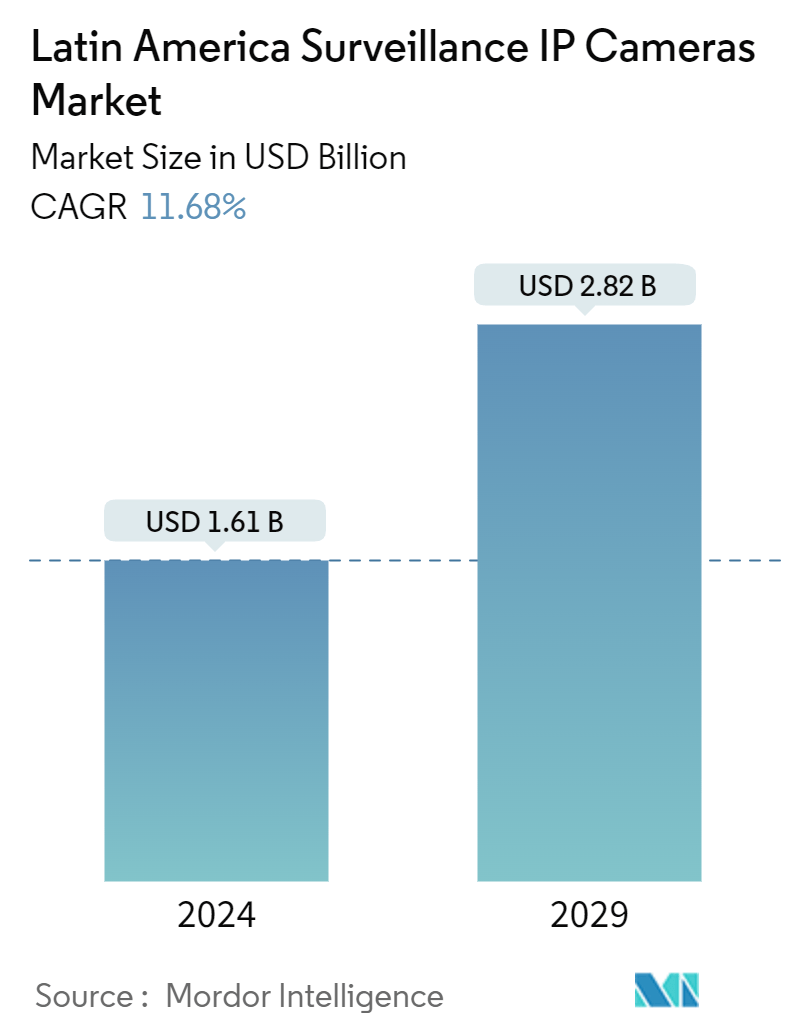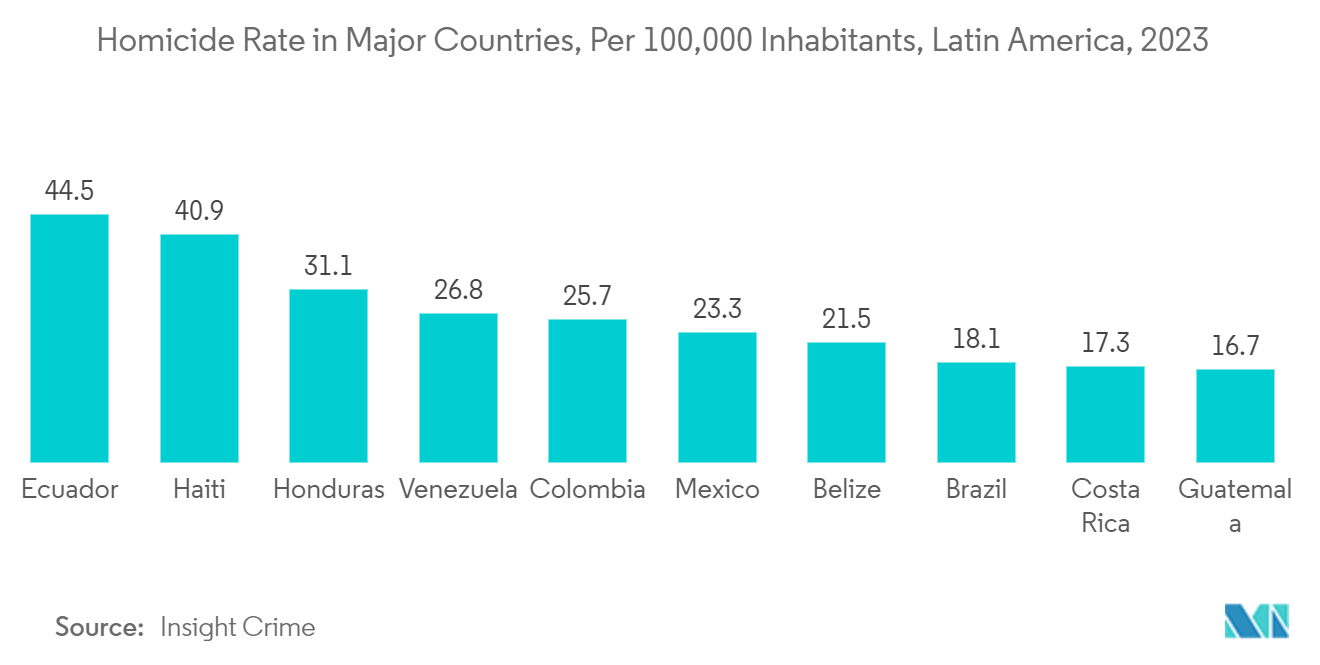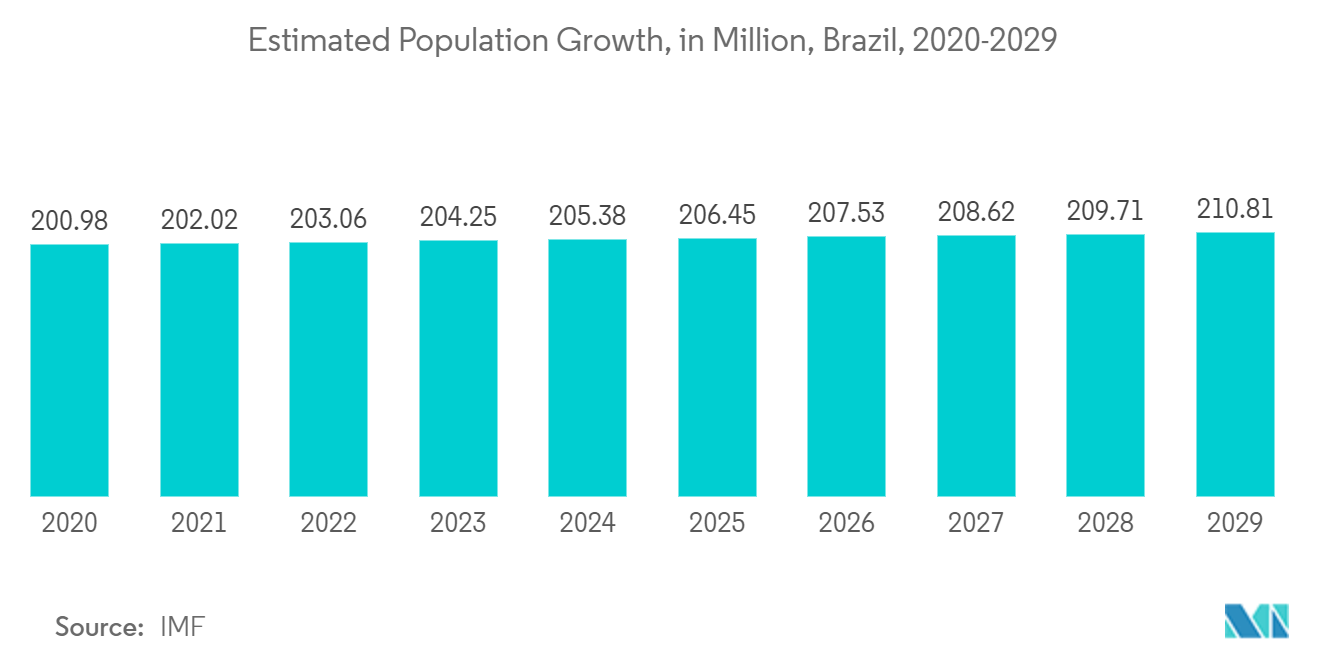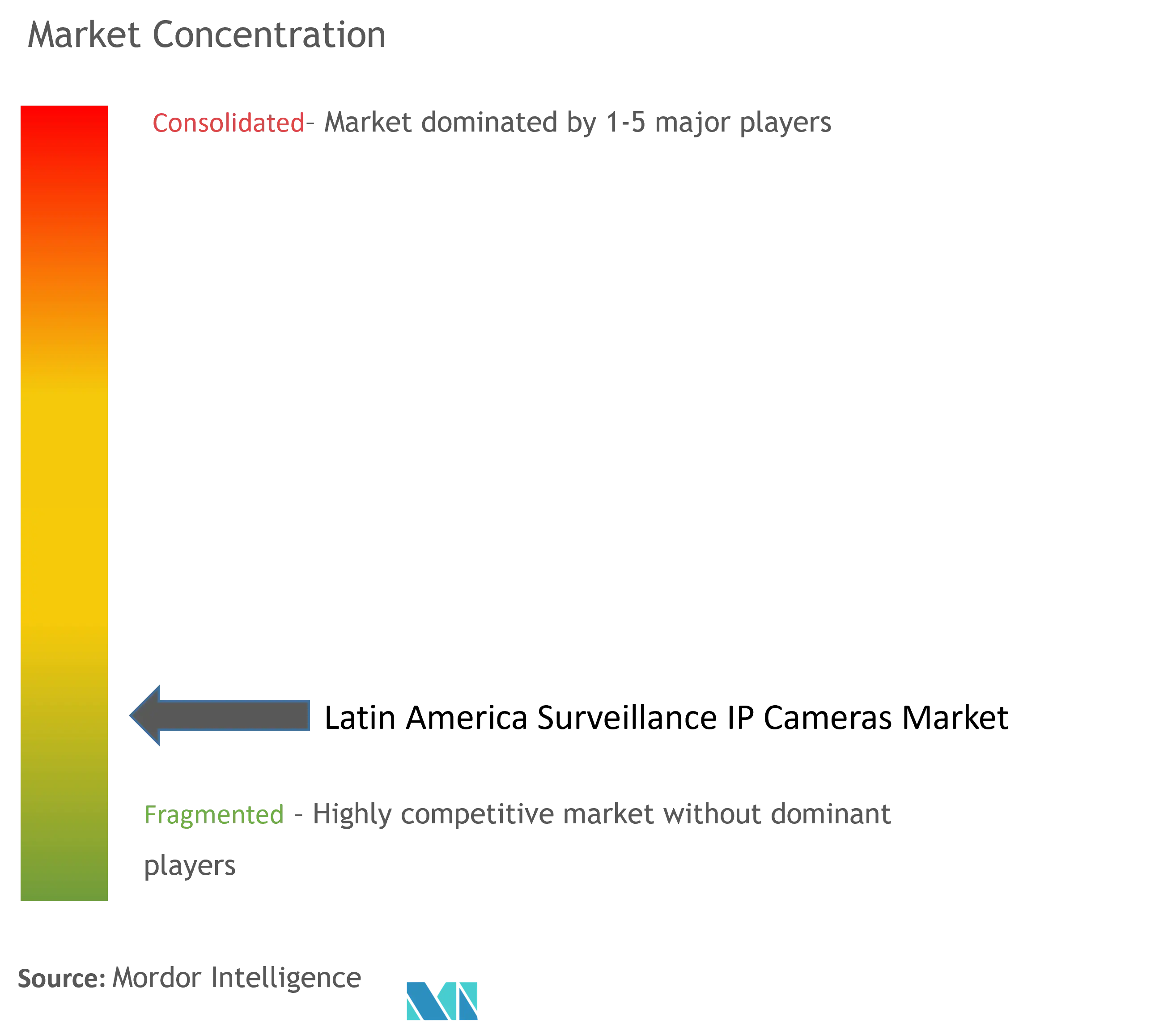Latin America Surveillance IP Cameras Market Size

| Study Period | 2019 - 2029 |
| Base Year For Estimation | 2023 |
| Market Size (2024) | USD 1.61 Billion |
| Market Size (2029) | USD 2.82 Billion |
| CAGR (2024 - 2029) | 11.68 % |
| Market Concentration | Low |
Major Players.webp)
*Disclaimer: Major Players sorted in no particular order |
Latin America Surveillance IP Cameras Market Analysis
The Latin America Surveillance IP Cameras Market size is estimated at USD 1.61 billion in 2024, and is expected to reach USD 2.82 billion by 2029, growing at a CAGR of 11.68% during the forecast period (2024-2029).
IP cameras, short for internet protocol cameras, facilitate digital video surveillance by transmitting and receiving footage over the internet or a local area network (LAN). As implied by their name, these cameras link to a network via WiFi or a Power over Ethernet (PoE) cable. They are frequently paired with network video recorders (NVRs) and occasionally with digital video recorders (DVRs), rendering them a prevalent choice for commercial or enterprise video surveillance.
• In Latin America, the push for enhanced public safety, led by government initiatives, is fueling a rising demand for cutting-edge security and surveillance solutions. This demand is further bolstered by the influx of multinational corporations (MNCs) into diverse sectors, spurring the proliferation of advanced surveillance technologies like CCTV and cameras. In addition, heightened consumer awareness directly translates into a surge in the adoption of surveillance cameras, collectively cultivating a conducive environment for the market's expansion in Latin America.
• For decades, a rising crime rate has plagued numerous Latin American nations, prompting both governments and businesses to take notice. Notably, as countries such as Brazil and Mexico emerge as key destinations for foreign direct investments, the imperative to bolster regional security has intensified. For instance, according to the Ministry of Economic Affairs (Mexico), during the first quarter of 2023, the total FDI in Mexico City was about USD 7 billion. Consequently, governments and consumers spanning various sectors increasingly turn to advanced surveillance solutions.
• This growth in demand has driven the attention of several global firms offering IP surveillance cameras, which are expanding their presence in the region. This, in turn, is driving the availability of a variety of products that consumers can choose from based on their individual requirements and use cases. Furthermore, such trends are also driving the interest of local businesses, encouraging them to expand their presence in the surveillance camera segment. For instance, in recent years, companies like i-Pro Americas Inc. have expanded their footprint in the Latin American region.
• Yet, the Latin American surveillance camera market faces hurdles to its growth. A key challenge stems from the higher costs associated with IP cameras. Latin American consumers, known for their price sensitivity, find elevated prices to be a significant barrier. In addition, harnessing the full potential of advanced IP cameras demands a robust infrastructure. This includes high-speed internet, uninterrupted power, and expert installation. These prerequisites not only elevate the installation costs but also make it challenging for SMEs to opt for IP cameras over their more affordable analog counterparts.
• The Latin American market initially faced a setback due to the pandemic, with disrupted supply chains and reduced demand from decreased commercial and industrial activities. However, it's now rebounding. Many consumers are upping their investments in advanced surveillance solutions, realizing the importance of staying updated for a safe return to work. In addition, features like occupancy detection through video analytics are gaining traction, especially among retailers, bolstering the market's growth prospects.
Latin America Surveillance IP Cameras Market Trends
Government Segment to Hold a Significant Market Share
- Crime and violence remain paramount concerns for Latin American households. The IMF reports that, despite representing a smaller portion of the global population, the region is home to nearly half of the world's intentional homicide victims. Latin America's average homicide rate far surpasses that of other emerging markets and developing economies. Notably, within Latin America, Central America emerges as the epicenter of violence. Furthermore, insecurity has escalated, particularly in select areas of the region.
- In 2023, Insight Crime, a non-profit think tank focusing on organized crime in Latin America and the Caribbean, reported that countries such as Ecuador, Haiti, Honduras, and Venezuela had the highest homicide rates in the region. Conversely, El Salvador boasted the lowest rate, standing at 2.4 homicides per 100,000 residents. Such trends are anticipated to drive opportunities in the studied market.
- Amid rising crime rates, numerous Latin American governments are proactively implementing measures, such as deploying cutting-edge surveillance cameras in key public areas. This strategic move aims to bolster the growth prospects of the surveillance market. The Brazilian government has unveiled ambitious plans to roll out extensive surveillance camera networks in prominent cities, including Sao Paulo and Rio de Janeiro.
- Other countries are also mirroring such initiatives. In Mexico, the government has been steadily deploying surveillance cameras. By the close of 2024, the aim is to have a minimum of 80,000 cameras in place. Alongside, the nation has introduced panic buttons at key sites. Moreover, a central command center, complemented by seven regional dispatch centers, now oversees the surveillance network with human operators.

Brazil to Hold a Significant Market Share
- Brazil, one of Latin America's largest nations, boasts a significant landmass and population. In 2023, the IMF reported Brazil's population at 204.25 million, with projections exceeding 210 million by 2029. With its expansive population and territory, Brazil places a premium on surveillance and security, fostering an environment conducive to the market's growth.
- Urbanization in Brazil has been on the rise. World Bank data shows that in 2023, 87.79% of Brazilians lived in urban areas, up from 86.04% in 2016. Given the dense population in urban centers, surveillance cameras are crucial for maintaining law and order and responding to emergencies, making them a key driver for the market's growth.
- Moreover, Brazil has experienced significant infrastructure growth in recent years. This surge is fueled by a growing population, urbanization, and increased foreign direct investments (FDIs) in industries. These factors are boosting the need for infrastructure, including commercial and residential buildings and transportation systems. Consequently, the demand for surveillance cameras, especially IP cameras, is rising, given the need for enhanced security measures.
- Recently, the Brazilian government announced a BRL 1 trillion (almost USD 200 billion) investment plan. This initiative, spanning the next four years, primarily targets infrastructure, energy, and transportation. The overarching goal is to revitalize economic growth and bolster employment rates in the nation.
- Furthermore, the rising crime rate in the country is another major factor that is anticipated to drive opportunities in the studied market. For instance, according to the Citizen Council for Public Safety and Penalty Justice, in 2023, Salvador was the leading city in Brazil in terms of the number of homicides, followed by cities like Recife, and Fortalenza, among others.

Latin America Surveillance IP Cameras Industry Overview
The Latin American region is among the most promising markets for IP cameras. The growing demand, owing to supportive government initiatives and increasing consumer acceptance, is attracting more players in the market, shifting the market's competitive landscape towards fragmentation. While the established multinational firms hold a significant market presence, the demand is attracting new market players, increasing competition among the vendors.
Some key market players include Hikvision, Bosch, Honeywell, and Dahua Technology, among others. To enhance their market presence further, these vendors are adopting various initiatives like product innovation, new product launches, partnerships, mergers, and acquisitions.
Considering the advantage IP cameras offer over their analog counterparts, the demand for these cameras is anticipated to grow further. Vendors in the market must focus on developing new products and including advanced features while enhancing the overall capability of these cameras to become a significant differentiator. Furthermore, establishing a geographical presence and quality customer support in the Latin American region will also help the vendors secure repeat business and gain a competitive edge in this competitive market.
Latin America Surveillance IP Cameras Market Leaders
-
Hangzhou Hikvision Digital Technology Co. Ltd
-
Bosch Security and Systems
-
Honeywell International Inc.
-
Dahua Technology
-
Hanwha Vision
*Disclaimer: Major Players sorted in no particular order

Latin America Surveillance IP Cameras Market News
- July 2024: Digital Watchdog (DW), a prominent player in the Latin American surveillance technology market, unveiled its latest innovation: the MEGApix Ai CaaS IP cameras. These cameras, available in a 4K bullet and 5MP turret design, feature white light LEDs. They stand out as all-in-one solutions, functioning not just as cameras but also as edge recorders. Equipped with DW Spectrum IPVMS and an edge-AI Deep Learning engine, these cameras boast advanced features like object detection and tracking. This slashes false alarms and optimizes storage usage, culminating in a more effective monitoring system.
- April 2024: ZKBio Sense, a leading provider of intelligent video surveillance solutions, has unveiled its latest innovation: IP cameras that leverage Deep-Learning algorithms and Computer Vision technology. These cameras, part of the ZKBio Sense series, boast a sophisticated CPU and an embedded intelligent classification algorithm. This combination enables them to precisely identify three primary targets: vehicles, humans, and objects. Notably, the cameras excel at filtering out irrelevant objects, minimizing false alarms.
- April 2024: Ajax Systems unveiled its newest line of wired security IP cameras. These cameras, rated at IP65 for both indoor and outdoor use, boast a passwordless authentication feature, ensuring a seamless and secure experience. Offering a range of matrix types and lenses, the camera lineup includes the TurretCam, BulletCam, and DomeCam Mini models.
- January 2024: Hikvision, a leading security solutions provider, bolsters its camera range with the introduction of Stealth Edition Cameras. These new additions sport sleek black housings, marrying aesthetics with cutting-edge functionality. Noteworthy features include 24/7 full-color capabilities through ColorVu technology, alongside advanced AI for human and vehicle detection powered by AcuSense.
Latin America Surveillance IP Cameras Market Report - Table of Contents
1. INTRODUCTION
1.1 Study Assumptions and Market Definition
1.2 Scope of the Study
2. RESEARCH METHODOLOGY
3. EXECUTIVE SUMMARY
4. MARKET INSIGHTS
4.1 Market Overview
4.2 Industry Value Chain Analysis
4.3 Industry Attractiveness - Porters' Five Force Analysis
4.3.1 Bargaining Power of Suppliers
4.3.2 Bargaining Power of Buyers
4.3.3 Threat of New Entrants
4.3.4 Threat of Substitute Products
4.3.5 Intensity of Competitive Rivalry
4.4 Impact Assessment of the Macroeconomic Trends on the Market
5. MARKET DYNAMICS
5.1 Market Drivers
5.1.1 Innovative Features Offered by IP Cameras
5.1.2 Growing Investment by Government and Consumers on Advanced Security & Surveillance Solutions
5.2 Market Restraints
5.2.1 Highe Cost & Availability of Substitutes
6. MARKET SEGMENTATION
6.1 By End User Industry
6.1.1 Banking and Financial Institutions
6.1.2 Transportation and Infrastructure
6.1.3 Government and Defense
6.1.4 Healthcare
6.1.5 Industrial
6.1.6 Retail
6.1.7 Enterprises
6.1.8 Residential
6.1.9 Other End User Industries
6.2 By Country***
6.2.1 Brazil
6.2.2 Mexico
6.2.3 Argentina
6.2.4 Colombia
6.2.5 Chile
7. COMPETITIVE LANDSCAPE
7.1 Company Profiles
7.1.1 Johnson Controls
7.1.2 Hangzhou Hikvision Digital Technology Co. Ltd
7.1.3 Sony Corporation
7.1.4 Honeywell International Inc.
7.1.5 Bosch Security and Systems
7.1.6 Dahua Technology
7.1.7 Panasonic Holdings Corporation
7.1.8 Pelco (Motorola Solutions Inc.)
7.1.9 GeoVision Inc.
7.1.10 The Infinova Group
7.1.11 Hanwha Vision
7.1.12 Zhejiang Uniview Technologies Co.,Ltd.
- *List Not Exhaustive
8. INVESTMENT ANALYSIS
9. FUTURE OUTLOOK OF THE MARKET
Latin America Surveillance IP Cameras Industry Segmentation
- An IP camera, short for internet protocol camera, is a digital security camera that transmits and receives video footage through an IP network. Primarily employed for surveillance, IP cameras stand distinct from traditional analog CCTV cameras in that they forego the need for a dedicated local recording device, relying solely on a local network. Much like phones and computers, IP cameras seamlessly integrate into a network for operation.
- The study comprehensively analyzes trends influencing the dynamics of the surveillance camera market in Latin America. It considers the sales of surveillance IP cameras by various market vendors in Latin America as the baseline for market estimations. Furthermore, the study also analyzes the influence of macroeconomic factors on the studied market's growth in Latin America.
- Latin American surveillance IP cameras market is segmented by end-user industry (banking and financial institutions, transportation and infrastructure, government and defense, healthcare, industrial, retail, enterprises, residential, and others) and by country (Brazil, Mexico, Argentina, rest of Latin America). The market sizes and forecasts are provided in terms of value (USD) for all the above segments.
| By End User Industry | |
| Banking and Financial Institutions | |
| Transportation and Infrastructure | |
| Government and Defense | |
| Healthcare | |
| Industrial | |
| Retail | |
| Enterprises | |
| Residential | |
| Other End User Industries |
| By Country*** | |
| Brazil | |
| Mexico | |
| Argentina | |
| Colombia | |
| Chile |
Latin America Surveillance IP Cameras Market Research FAQs
How big is the Latin America Surveillance IP Cameras Market?
The Latin America Surveillance IP Cameras Market size is expected to reach USD 1.61 billion in 2024 and grow at a CAGR of 11.68% to reach USD 2.82 billion by 2029.
What is the current Latin America Surveillance IP Cameras Market size?
In 2024, the Latin America Surveillance IP Cameras Market size is expected to reach USD 1.61 billion.
Who are the key players in Latin America Surveillance IP Cameras Market?
Hangzhou Hikvision Digital Technology Co. Ltd, Bosch Security and Systems, Honeywell International Inc., Dahua Technology and Hanwha Vision are the major companies operating in the Latin America Surveillance IP Cameras Market.
What years does this Latin America Surveillance IP Cameras Market cover, and what was the market size in 2023?
In 2023, the Latin America Surveillance IP Cameras Market size was estimated at USD 1.42 billion. The report covers the Latin America Surveillance IP Cameras Market historical market size for years: 2019, 2020, 2021, 2022 and 2023. The report also forecasts the Latin America Surveillance IP Cameras Market size for years: 2024, 2025, 2026, 2027, 2028 and 2029.
Latin America Surveillance IP Cameras Industry Report
Statistics for the 2024 Latin America Surveillance IP Cameras market share, size and revenue growth rate, created by Mordor Intelligence™ Industry Reports. Latin America Surveillance IP Cameras analysis includes a market forecast outlook for 2024 to 2029 and historical overview. Get a sample of this industry analysis as a free report PDF download.



